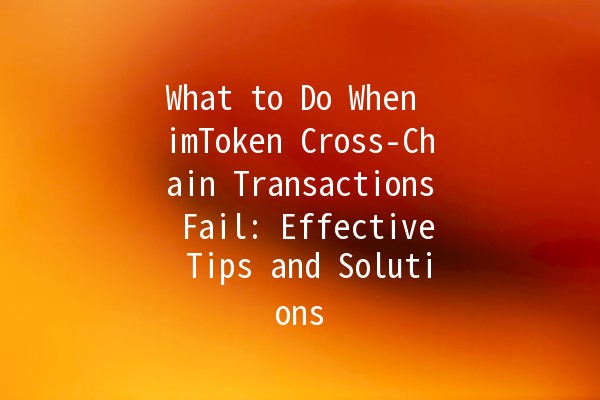In the world of cryptocurrency, crosschain transactions are a vital aspect, enabling users to interact with various blockchain networks efficiently. However, encountering failures during these transactions can be frustrating. This article aims to provide actionable steps to take when dealing with imToken crosschain transaction failures. It also includes productivityenhancing tips to ensure smooth transactions in the future.
Crosschain transactions allow users to transfer assets from one blockchain to another. imToken, a popular wallet in the cryptocurrency ecosystem, supports these transactions, enabling users to manage multiple digital assets seamlessly. Occasionally, transactions may fail due to various reasons, including network issues, incorrect wallet addresses, or insufficient gas fees.
Knowing how to address these failures is crucial for maintaining your cryptocurrency portfolio and ensuring smooth transactions. Here’s how to effectively navigate this space when issues arise.

Network congestion occurs when the blockchain is overwhelmed with transactions, leading to delays and potential failures. High transaction volumes can result in lag and rejection of your transaction.
Simple mistakes, such as entering the wrong recipient address or selecting the incorrect asset for transfer, can cause your transaction to fail. It is imperative to doublecheck all details before proceeding.
Each transaction on a blockchain requires a gas fee to incentivize miners to process and confirm the transaction. If the gas fee is set too low, your transaction may sit in the pending queue or fail entirely.
Sometimes, the failure can stem from technical issues within the imToken application or the respective blockchain network. These glitches can occur without warning and may require troubleshooting.
Crosschain transactions often include builtin security features that can halt a transaction if suspicious activity is detected. This is a protective measure designed to keep your assets safe but can lead to unnecessary failures in legitimate transactions.
Explanation: Ensure you’re sending cryptocurrency to the correct wallet address. This cannot be stressed enough—one digit wrong can send your assets into the abyss.
Example: Before confirming a transaction, copy and paste the recipient's address directly instead of typing it out. This minimizes human error.
Explanation: Keep an eye on the network conditions of both the source and destination blockchains. Tools like blockchain explorers can help you determine current transaction volumes.
Example: If you observe high congestion, it may be prudent to wait before executing your transaction or adjust the gas fees accordingly.
Explanation: Always set a gas fee that reflects current market conditions. During peak times, a higher gas fee can mean the difference between a confirmed transaction and one that fails.
Example: Use platforms like GasNow to check realtime gas prices and set an appropriate gas fee to improve the chances of your transaction being validated quickly.
Explanation: Technical glitches can often be resolved by refreshing the application or restarting your device. This can help clear out any temporary issues that may be causing the transaction failure.
Example: If your transaction fails, close the imToken app completely and reopen it before attempting to send your transaction again.
Explanation: Sometimes, security settings may prevent transactions from going through. Check if your wallet has any additional security protocols, such as limits on transaction amounts or certain tokens.
Example: If your transaction is blocked, review your wallet settings and adjust them as necessary, ensuring you're aware of any imposed limits.
When a crosschain transaction fails in imToken, here are the steps you should take to troubleshoot:
Check the transaction history within your imToken wallet to find details about the failed transaction. This information can provide insights into what went wrong.
If imToken provides an error message, take note of it. Many platforms will include a brief description explaining why the transaction failed.
If you cannot resolve the issue, consider reaching out to imToken's customer support. They may provide specific insights or solutions based on your case.
After identifying and correcting any issues, try executing the transaction again, ensuring you’ve made the necessary adjustments.
If your transaction is stuck, first check the current network status. Then, try adjusting the gas fees, or if possible, cancel the transaction and attempt it again with revised parameters.
To enhance security, regularly update your wallet app, enable twofactor authentication, and never share your private keys. Utilize reputable networks for transactions.
Gas fees are transaction fees paid to miners for processing transactions. To manage gas fees, monitor market rates regularly and set competitive fees beforehand based on network conditions.
Generally, once a transaction is submitted to the blockchain, it cannot be reversed. However, if it fails to process due to low gas fees, you may attempt to increase the fee and resend the transaction.
When selecting a multichain wallet, consider factors such as ease of use, security features, supported networks, and customer support. These elements can significantly impact your user experience.
To improve transaction speed, ensure adequate gas fees are set, monitor network congestion, and refrain from executing transactions during peak hours if possible.
Navigating the complexities of crosschain transactions can be challenging, especially when failures occur. With the right knowledge and proactive strategies, users can minimize disruptions and ensure smoother transactions. On that note, always keep these tips in mind to handle any unforeseen challenges. Happy trading!